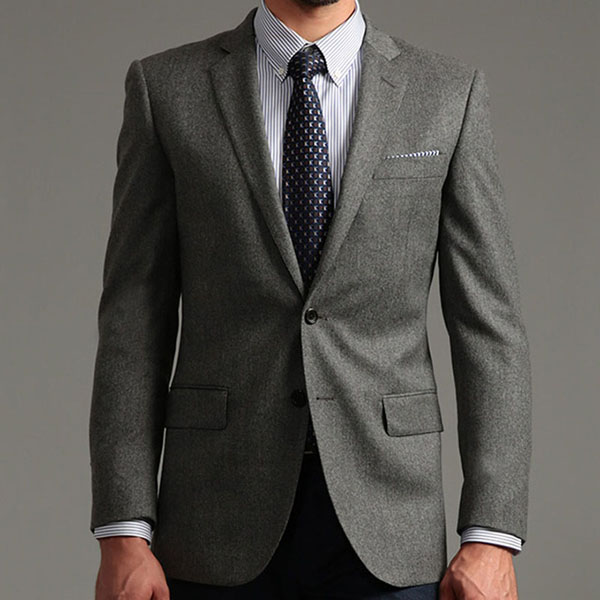When you choose to customize a suit, the first thing you need to consider is the choice of suit fabric. Because different fabrics adapt to different styles, the styles of the suits are also completely different. The following is the same as Let’s talk about the fabrics and styles of customized suits!

Textile material
Suit fabrics can be divided into natural fabrics and non-natural fabrics from textile materials, that is, pure wool fabrics (what is called “pure” in wool textiles, generally more than 95% can be said to be “pure”) and blended fabrics. The “pure wool” fabric for suit fabrics generally refers to pure wool. Most of them are thin in texture, have a natural and soft luster, are crisp and drapey, and have a soft feel. The disadvantages are that they are not resistant to wear and tear, and are prone to insects and mildew. In addition to wool, there is also cashmere, which is called “soft gold” and is very warm to wear. Cashmere is about eight times as warm as wool, yet very lightweight, about one-fifth as much.
The wool content determines the basic grade of the fabric. Common wool contents are about 30%, 50%, 70%, 90% and above. For most people, it is enough to choose one with a hair content of 80% or 90%. Good wool fabrics have different prices depending on the breed of sheep.
Textile technology
According to the textile technology, custom-made suit fabrics can be divided into worsted spinning technology and woolen spinning technology. The raw materials used in worsted spinning are of higher quality, and yarns with high twist and low hairiness are spun (generally single-ply yarns and ply yarns). Worsted products have a lighter, thinner feel, denser texture, and better wet fastness, so their prices are higher.
Generally, worsted fabrics are used to make customized suits. Worsted fabrics are finely woven and are used in all formal suits or dresses; woolen fabrics are rough in style, with a thin layer of velvet on the surface, and plaid patterns are very common, making them warm and comfortable.
Weight
The weight of custom-made suit fabrics refers to the weight of the fabric in grams per square meter. Generally, the fabric will be marked OZ (ounces) or G (grams). When the fabric count is the same, the higher the weight, the thicker and tighter the fabric will be, but this does not mean that the heavier the fabric, the more expensive it will be. The higher the gram count, the stronger and more durable the fabric will be, while also having a straighter drape. When choosing fabrics, weight is more important than thread count.
To put it simply, the 280-320g range is not a big problem in all seasons. The upper range is suitable for winter, and the lower range is more suitable for summer. In addition, according to regional temperature differences, you can choose those with higher weight in the north and those with lower weight in the south.
For fabrics, count is one of the quality indicators for measuring fabrics, but there is no necessary relationship between fabric count and fabric quality. For most people, the thread count of suit fabrics is not worth worrying about. In theory, higher thread counts will be more delicate and softer than lower thread threads.
But in most cases, British materials of the same grade with lower counts feel much better than similar Italian materials (even if the count is higher). Therefore, the count can only be used as a reference factor.
There are also colors and patterns of custom-made suit fabrics, which are the same as the selection criteria for the count of custom-made suit fabrics – based on the wearing occasion. There are generally agreed-upon rules for attending different occasions, so consider the purpose of the suit when choosing fabrics. Compared with the count, the choice of color can be more subjective and personal, while the aesthetics requires your own matching skills.
Features of customized suits:
British version: waistline
Britain is the origin of traditional suits, the obvious features of which are the three-dimensional shoulder lines and exaggerated narrow waist lines, which can easily modify the figure and make the chest feel tall and straight.
Italian fit: silhouette
The Italian version has more free and romantic characteristics: the shoulder line is narrower than the British version, the three-dimensional upper sleeves using pleated technology, and the collar and arm curves appear more graceful.
American fit: Casual
The classic American version is the Ivy version of the 1950s. Its version is more casual and loose, with an overall silhouette that is roughly O-shaped, with natural shoulder lines, no or only thin shoulder pads, and curvature. Sliding shoulders makes people look more natural.
Japanese version: rigorous
The Japanese style has strict characteristics. The top is wider and basically H-shaped. The shoulders are not particularly wide. They are usually single-breasted. There are no slits in the back of the clothes (because Japanese people are not tall, so slits will look cumbersome). ).
Suit customization allows you to no longer worry about the choice of pattern and fabric, because I can recommend different suits for you to wear on different occasions. For example, for ordinary work clothes, we can choose wool-like fabrics. If the attendance is important…In combination, we can choose wool-containing fabrics. For more information, please pay attention to our dynamic updates.
Tag: Customized suits





